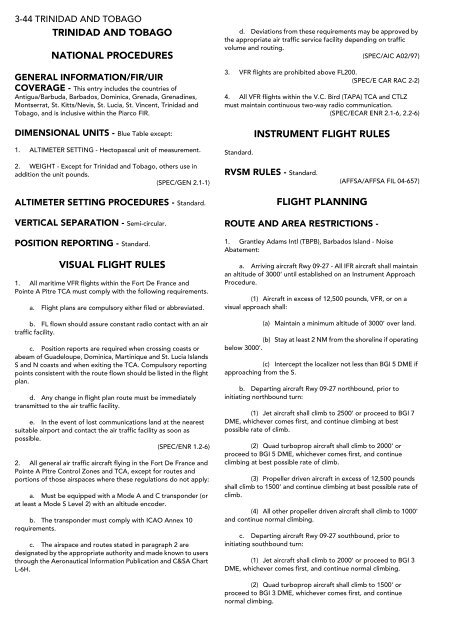NORTH AND SOUTH AMERICA - CNATRA - The US Navy
NORTH AND SOUTH AMERICA - CNATRA - The US Navy
NORTH AND SOUTH AMERICA - CNATRA - The US Navy
Create successful ePaper yourself
Turn your PDF publications into a flip-book with our unique Google optimized e-Paper software.
3-44 TRINIDAD <strong>AND</strong> TOBAGO<br />
TRINIDAD <strong>AND</strong> TOBAGO<br />
NATIONAL PROCEDURES<br />
GENERAL INFORMATION/FIR/UIR<br />
COVERAGE - This entry includes the countries of<br />
Antigua/Barbuda, Barbados, Dominica, Grenada, Grenadines,<br />
Montserrat, St. Kitts/Nevis, St. Lucia, St. Vincent, Trinidad and<br />
Tobago, and is inclusive within the Piarco FIR.<br />
DIMENSIONAL UNITS - Blue Table except:<br />
1. ALTIMETER SETTING - Hectopascal unit of measurement.<br />
2. WEIGHT - Except for Trinidad and Tobago, others use in<br />
addition the unit pounds.<br />
(SPEC/GEN 2.1-1)<br />
ALTIMETER SETTING PROCEDURES - Standard.<br />
VERTICAL SEPARATION - Semi-circular.<br />
POSITION REPORTING - Standard.<br />
VISUAL FLIGHT RULES<br />
1. All maritime VFR flights within the Fort De France and<br />
Pointe A Pitre TCA must comply with the following requirements.<br />
a. Flight plans are compulsory either filed or abbreviated.<br />
b. FL flown should assure constant radio contact with an air<br />
traffic facility.<br />
c. Position reports are required when crossing coasts or<br />
abeam of Guadeloupe, Dominica, Martinique and St. Lucia Islands<br />
S and N coasts and when exiting the TCA. Compulsory reporting<br />
points consistent with the route flown should be listed in the flight<br />
plan.<br />
d. Any change in flight plan route must be immediately<br />
transmitted to the air traffic facility.<br />
e. In the event of lost communications land at the nearest<br />
suitable airport and contact the air traffic facility as soon as<br />
possible.<br />
(SPEC/ENR 1.2-6)<br />
2. All general air traffic aircraft flying in the Fort De France and<br />
Pointe A Pitre Control Zones and TCA, except for routes and<br />
portions of those airspaces where these regulations do not apply:<br />
a. Must be equipped with a Mode A and C transponder (or<br />
at least a Mode S Level 2) with an altitude encoder.<br />
b. <strong>The</strong> transponder must comply with ICAO Annex 10<br />
requirements.<br />
c. <strong>The</strong> airspace and routes stated in paragraph 2 are<br />
designated by the appropriate authority and made known to users<br />
through the Aeronautical Information Publication and C&SA Chart<br />
L-6H.<br />
d. Deviations from these requirements may be approved by<br />
the appropriate air traffic service facility depending on traffic<br />
volume and routing.<br />
(SPEC/AIC A02/97)<br />
3. VFR flights are prohibited above FL200.<br />
(SPEC/E CAR RAC 2-2)<br />
4. All VFR flights within the V.C. Bird (TAPA) TCA and CTLZ<br />
must maintain continuous two-way radio communication.<br />
(SPEC/ECAR ENR 2.1-6, 2.2-6)<br />
Standard.<br />
INSTRUMENT FLIGHT RULES<br />
RVSM RULES - Standard.<br />
FLIGHT PLANNING<br />
ROUTE <strong>AND</strong> AREA RESTRICTIONS -<br />
(AFFSA/AFFSA FIL 04-657)<br />
1. Grantley Adams Intl (TBPB), Barbados Island - Noise<br />
Abatement:<br />
a. Arriving aircraft Rwy 09-27 - All IFR aircraft shall maintain<br />
an altitude of 3000’ until established on an Instrument Approach<br />
Procedure.<br />
(1) Aircraft in excess of 12,500 pounds, VFR, or on a<br />
visual approach shall:<br />
(a) Maintain a minimum altitude of 3000’ over land.<br />
(b) Stay at least 2 NM from the shoreline if operating<br />
below 3000’.<br />
(c) Intercept the localizer not less than BGI 5 DME if<br />
approaching from the S.<br />
b. Departing aircraft Rwy 09-27 northbound, prior to<br />
initiating northbound turn:<br />
(1) Jet aircraft shall climb to 2500’ or proceed to BGI 7<br />
DME, whichever comes first, and continue climbing at best<br />
possible rate of climb.<br />
(2) Quad turboprop aircraft shall climb to 2000’ or<br />
proceed to BGI 5 DME, whichever comes first, and continue<br />
climbing at best possible rate of climb.<br />
(3) Propeller driven aircraft in excess of 12,500 pounds<br />
shall climb to 1500’ and continue climbing at best possible rate of<br />
climb.<br />
(4) All other propeller driven aircraft shall climb to 1000’<br />
and continue normal climbing.<br />
c. Departing aircraft Rwy 09-27 southbound, prior to<br />
initiating southbound turn:<br />
(1) Jet aircraft shall climb to 2000’ or proceed to BGI 3<br />
DME, whichever comes first, and continue normal climbing.<br />
(2) Quad turboprop aircraft shall climb to 1500’ or<br />
proceed to BGI 3 DME, whichever comes first, and continue<br />
normal climbing.

















